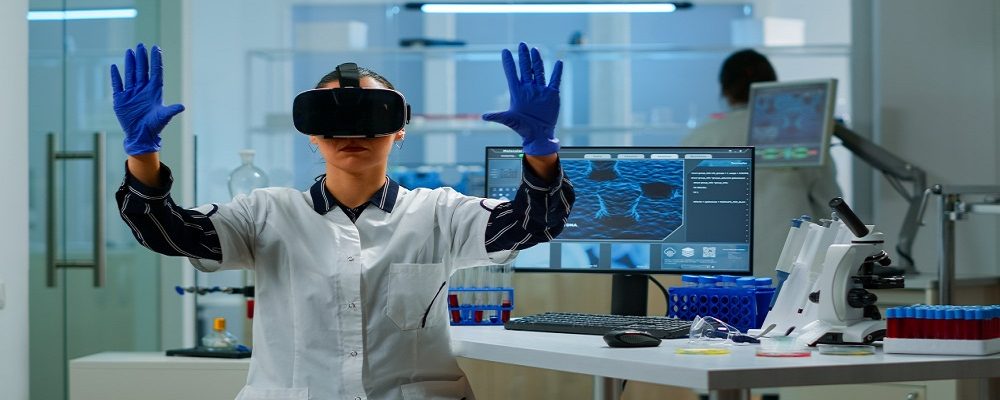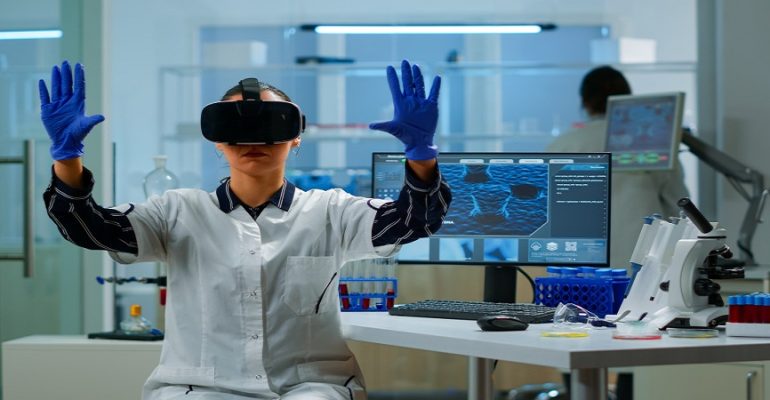
14 Potential Benefits of Virtual Reality in Healthcare

14 Potential Benefits of Virtual Reality in Healthcare
The development of new technologies is rapidly changing the world and how different sectors are integrating it to make things easier and improve the process. Previously VR has primarily been used in the gaming industry. But nowadays it is becoming increasingly common in fields that include Engineering, Education, Architecture, and Healthcare.
Virtual Reality has become a game-changer in the Healthcare industry after the Covid-19 Pandemic. There is numerous applications of VR that are already being used in the Healthcare industry.
We will go over every aspect of virtual reality (VR) in healthcare in this blog, including how it functions and its benefits in healthcare.
What is Virtual Reality?
VR is a computer-generated 3D environment that displays provides a three-dimensional image on the screen to the user. VR has already created a lot of impact in almost every industry with more opportunities.
According to recent reports, VR in the healthcare industry is expected to grow by $ 7.05 billion by the end of 2026.
What is Virtual Reality in Healthcare?
VR in healthcare is used for several applications. There are numerous applications of VR in healthcare that includes medical training for both students & doctors, diagnosis of ailments, Robotic surgery, and pain reduction treatments.
VR also helps patients in communicating and improving their quality of life in real-time. Patients’ health can be improved by making conjunction of technology and therapies. VR headsets make you feel as if you are in a doctor’s office. It serves as an amazing tool for patient care. Many VR development companies are constantly building new apps to improve the quality of healthcare.
Let’s get into the topic by writing the benefits of VR for Medical Professionals, Patients, and other executives.
Benefits of VR for Medical Professionals
VR is becoming a new trend as simulated delivery. It benefits both the learners and educators with cost-effective and standardized clinical training. VR simulation is repeatable, and it allows medical professionals to make mistakes and repeat the simulation process multiple times to increase performance.
1. Improved outcomes through VR surgery mapping
VR is being integrated into simulation-based training. This technology would outperform current distance learning packages and 2-dimensional videos by creating a nearly true experience from the operator’s perspective. Much of the research are using VR headsets and hand controllers in the virtual world of the operating surgeon.
Most VR devices include a tool for interacting with the virtual world. Endoscopy and robotic surgery may find useful.
2. Empathy Training
Doctors can identify the patients’ sufferings from the simulation video. By embedding VR, Doctors can hear the thoughts of the patients and how they feel.
It allows the doctors to experience the pain and discomfort from the patient’s point of view in the real world.
3. More surgical practice opportunities and greater flexibility.
VR helps surgeons virtually inspect the patient’s anatomy before performing surgery. These procedures even provide various alternative approaches to find the safest option.
Doctors can wear VR goggles and walk through the patient’s anatomy such as the brain and heart to provide the best treatment.
4. Medical Education that is financially affordable
Simulation is becoming a keystone in medical training by providing more efficiency in less amount of time. VR provides benefits for both teachers and students by giving cost-effective and systematic medical training.
Benefits of VR for Patients
In a video game-like setting VR can simulate and convey “how the patient is feeling”. It also educates patients about following a positive lifestyle and stopping intoxication etc.
5. Greater Accessibility
By providing an alternative form of interaction, VR can improve the experience of patients with disabilities. By incorporating various senses, VR can help patients to enjoy the virtual environment.
Many blind patients play video games using audio and haptic feedback.
6. Data and Monitoring
With the help of movement tracking capabilities used in VR headsets, VR applications can provide real-time data about patients’ progress. The connected devices are more helpful in securely storing the data of the patients.
XRHealth is a VR therapy that can be seen as the future of patient care. Here it allows the patients to get care from multiple providers.
7. Customizable Experiences
Patients’ treatment experiences can be customized and often adjusted in real time by monitoring healthcare providers. Patients who have gone through the traditional method of treatment can now use the specialized treatment through VR without any additional costs.
8. Comprehensive approach to health
VR is not only meant to treat any specific condition. It can treat multiple types of ailments such as disabilities and different types of pains. VR does not limit the patients with few opportunities, but it fosters social interaction and eliminates depression.
9. Non-invasive pain relief
VR has been effective in guiding women through labour. The same type of procedures for use for patients with chronic pain and trauma.
Benefits of VR for Healthcare Administrators and Hospital Executives.
Patients care can be enhanced by the involvement of immersive experiences and helps in cost-cutting.
10. Cost saving
Immersive VR teaching from hospitals and labs can cut costs by hosting live operating rooms for remote students. VR training can reduce a large number of medical errors which can cause severe effects and reduce administrative burden.
11. More engaging compliance training
Integrating VR into compliance can increase employee engagement and lower costs. VR can combine different training modules into a single solution.
12. Reputation for creativity
VR is growing at a fast pace and healthcare is the prominent adopter and standing ahead of the curve. These types of innovative technologies help medical schools to attract more people and provide immersive training to both students and staff.
13. Great Retention
According to recent students, employees who go through lecture training have less retention rate of 5% and those who go through VR training have a high retention rate of 75%. VR will increase lifesaving safety measures.
14. More efficient and faster training
When compared to classroom learners, VR trainees are 50% more focused on the training. This will allow them to complete the training soon and get to the floor.
What the future holds for Virtual Reality in Healthcare?
The potential of VR in Healthcare is growing at a faster pace and the applications of VR rapidly expanding in every area of healthcare. The VR technology will be more cost-effective, and this will help healthcare providers to deliver the best possible care. VR also improves the quality of life, especially for patients with certain disorders and psychological conditions.
Sapizon Technologies is the pioneer VR solution development company in building affordable healthcare solutions.
